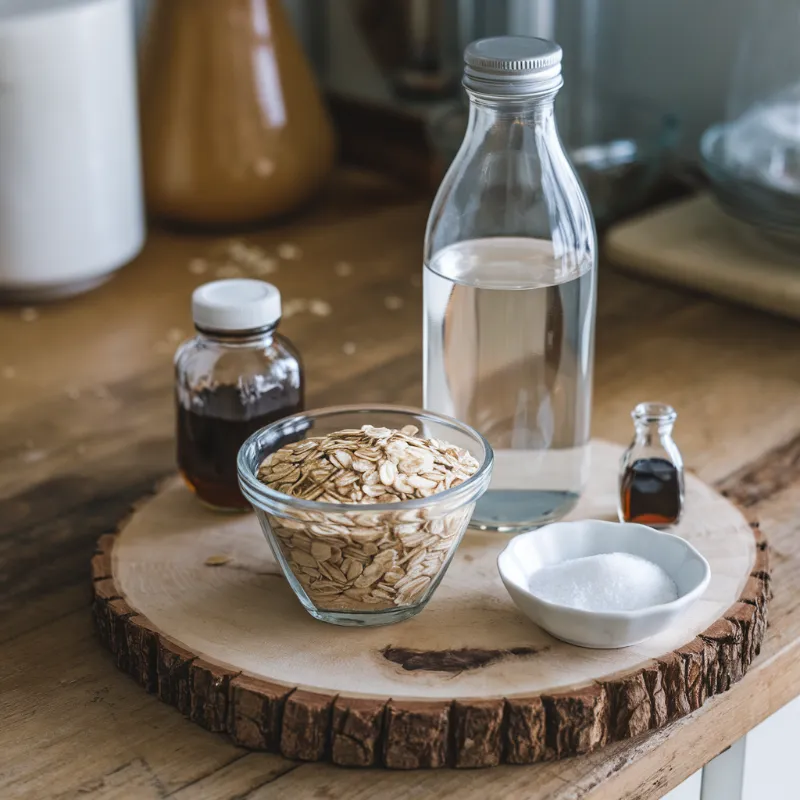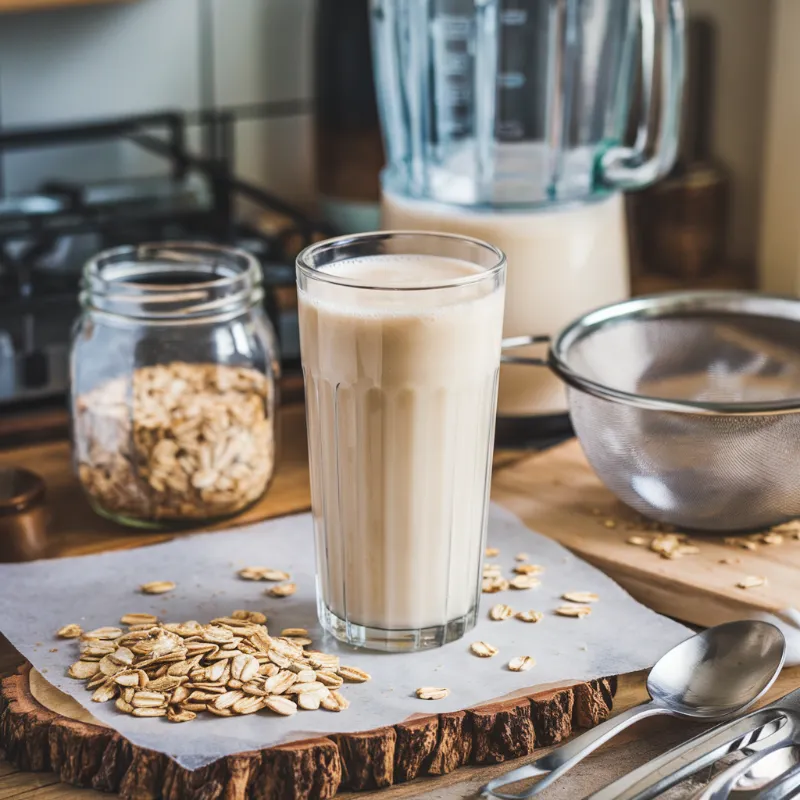Picture this: it’s a hectic Monday morning, and you’re rushing to make breakfast. You reach for your cereal, only to realise you’re out of your usual dairy option. Sound familiar? That’s where my homemade recipe comes to the rescue!
Creating your own dairy alternative is simpler than you might think. With just a few ingredients and a blender, you can whip up a creamy, delicious drink in minutes. Plus, making it at home means you’re in control of what goes into it—perfect for those with dietary sensitivities.
This recipe isn’t just quick; it’s incredibly versatile. Use it in your morning coffee, pour it over granola, or blend it into smoothies. It’s a game-changer for busy home cooks who want a fuss-free, nutritious option. Ready to give it a try? Let’s get started!
Table of Contents
Understanding Gluten Free Oat Milk and Its Importance
For many, choosing the right ingredients is more than just a preference—it’s a necessity. Whether you’re managing dietary restrictions or simply prioritising health, understanding what goes into your food is crucial. This is especially true when it comes to grains like oats, which are often misunderstood.
What Makes Oats Naturally Safe?
In their pure form, oats are inherently safe for those avoiding certain grains. They don’t naturally contain the proteins found in wheat, barley, or rye that can cause issues for some people. This makes them a great starting point for creating alternatives like oat-based drinks.
However, the journey from field to table isn’t always straightforward. During processing, oats can come into contact with other grains, particularly wheat. This is where the risk of cross-contamination arises, turning a naturally safe product into one that might not be suitable for everyone.
The Issue of Cross-Contamination
Cross-contamination occurs when oats are processed on the same equipment as gluten-containing grains. Even small traces can make a product unsafe for those with sensitivities. “It’s not just about the oats themselves—it’s about how they’re handled,” explains a food safety expert.
This is why it’s essential to look for products that are specifically marked as safe. Certified options ensure that strict measures are in place to prevent contamination. Knowing the origin and processing methods of your ingredients can make all the difference.
By choosing carefully, you can enjoy the benefits of oats without compromising your health. It’s a small step that can have a big impact on your well-being.
Benefits of Gluten Free Oat Milk for a Healthier Lifestyle
Switching to a healthier lifestyle doesn’t have to mean sacrificing taste or convenience. A creamy, plant-based drink can be a game-changer for your daily routine. It’s not just about avoiding certain ingredients—it’s about embracing a choice that supports your well-being.
Nutritional Value and Health Benefits
This drink is packed with essential nutrients that make it a standout choice. It contains protein, which is vital for muscle repair and energy. Unlike many alternatives, it also offers a good amount of fibre, helping to keep your digestion on track.
Rich in beta-glucans, this drink can help lower cholesterol and support heart health. It’s also fortified with calcium and potassium, making it a great option for maintaining strong bones. Plus, it’s naturally lactose-free, so it’s gentle on your stomach.
Considerations for Coeliac Disease and Gluten Sensitivities
For those with coeliac disease or gluten sensitivities, choosing the right drink is crucial. This option is specifically designed to meet those needs, ensuring it’s safe and nutritious. Always check labels to avoid any risk of cross-contamination.
Incorporating this drink into your diet can be a simple yet effective way to stay healthy. Whether you’re using it in your morning coffee or blending it into a smoothie, it’s a versatile addition to any meal plan.
Verifying Gluten Free Oats and Labels: An In-Depth Look
When it comes to choosing the right ingredients, knowing what to look for is half the battle. Understanding product labels can make all the difference in ensuring your food is safe and suitable for your dietary needs. Let’s dive into the key details you need to know.
How to Identify Certified Gluten Free Products
Start by checking for the “gluten free” label on the packaging. This is the most straightforward way to ensure the product meets strict safety standards. Certified products are tested to contain less than 20 parts per million of gluten, making them safe for most people with sensitivities.
Look for additional allergen information on the packaging. Manufacturers often include statements like “processed in a facility that handles wheat” or “may contain traces of gluten.” While these warnings are helpful, certified products should still meet the required safety levels.
When ordering online or in-store, always prioritise products with clear labelling. Reputable brands like Bob’s Red Mill and Quaker offer certified options that are processed in dedicated facilities to avoid cross-contamination. This extra step ensures you’re getting a product you can trust.
Finally, be aware of common mislabelling issues. Some products may claim to be safe but fail to meet certification standards. Always double-check the label and look for certifications from organisations like the Gluten-Free Certification Organisation (GFCO). This way, you can enjoy your food with confidence.

Homemade Versus Store-Bought Gluten Free Oat Milk
Deciding between homemade and store-bought options can be a game-changer for your daily routine. Both have their unique benefits, and understanding these can help you make the best choice for your needs.
DIY Recipe Tips for a Creamy Oat Milk
Making your own drink at home is simpler than you might think. Start with certified gluten-free oats and soak them for 15 minutes. Blend with water until smooth, then strain through a nut milk bag for a silky texture.
For a creamier consistency, use a 1:3 ratio of oats to water. Adding a pinch of salt or a splash of vanilla extract can enhance the flavour. Homemade versions are fresher and free from additives, giving you full control over the ingredients.
Top Gluten Free Oat Milk Brands in the UK
If you prefer convenience, several trusted brands offer excellent options. Rude Health is known for its rich, creamy texture, while Glebe Farm provides a budget-friendly choice without compromising quality. Alpro’s barista oat milk is a favourite for its ability to froth perfectly in coffee.
| Criteria | Homemade | Store-Bought |
|---|---|---|
| Taste | Customisable | Consistent |
| Texture | Varies | Creamy |
| Cost | Affordable | Higher |
| Convenience | Time-consuming | Ready-to-use |
Experiment with both options to find your ideal match. Whether you’re a home cook or a busy professional, there’s a perfect choice for you.
Versatile Uses of Gluten Free Oat Milk in Everyday Recipes
There’s something incredibly satisfying about finding a versatile ingredient that fits seamlessly into your daily routine. Whether you’re whipping up a morning brew or experimenting with new recipes, this dairy alternative can elevate your cooking and beverages in surprising ways.
Enhancing Coffee, Lattes and Teas
If you’re a coffee lover, you’ll appreciate how this drink can transform your morning cup. Its creamy texture makes it perfect for lattes, adding a smooth richness that pairs beautifully with espresso. Many coffee shops across the UK now feature it as a staple option, and it’s easy to see why.
For teas, it’s equally impressive. Whether you’re brewing a classic English breakfast or a fragrant chai, it blends effortlessly, enhancing the flavour without overpowering it. If you’re feeling adventurous, try adding a hint of coconut for a tropical twist.
Great Ideas for Baking, Cooking and Smoothies
In the kitchen, this ingredient shines as a 1:1 replacement for dairy. Use it in cakes, muffins, or pancakes for a lighter, fluffier texture. It’s also fantastic in savoury dishes like creamy soups or sauces, adding depth without heaviness.
Smoothies are another area where it excels. Blend it with your favourite fruits, a handful of spinach, and a splash of vanilla for a nutritious, refreshing drink. The possibilities are endless, and the results are always delicious.
| Use | Benefit |
|---|---|
| Coffee | Creamy texture, froths well |
| Baking | Light, fluffy results |
| Smoothies | Nutritious, blends easily |
| Cooking | Adds depth to savoury dishes |
From your morning latte to your evening dessert, this ingredient is a game-changer. Why not pick some up from your local store and start experimenting today?
Gluten Free Oat Milk: Buyer’s Guide Tips
Navigating the world of plant-based drinks can feel overwhelming, but with the right tips, it’s easier than you think. Whether you’re new to this or a seasoned shopper, knowing what to look for can make all the difference. Let’s break it down step by step so you can shop with confidence.
Key Information to Look For on Product Labels
When picking a product, the label is your best friend. Start by checking the sugar content. Some brands add extra sweetness, which might not align with your health goals. Look for options with minimal added sugar for a healthier choice.
Next, scan the ingredients list. Avoid products with artificial additives or preservatives. A shorter list often means a cleaner, more natural drink. Also, keep an eye out for certifications like “gluten-free” to ensure it meets safety standards.
Finally, assess the nutritional value. Look for drinks fortified with calcium or vitamins to support your overall health. A well-rounded product can be a great addition to your diet.
Avoiding Cross-Contamination in Coffee Shops and Stores
When ordering out, it’s important to ask the right questions. Start by inquiring about the equipment used. Are the blenders and steamers dedicated to gluten-free drinks? This simple question can help you avoid cross-contamination.
In stores, check the packaging for any warnings about shared facilities. If you’re unsure, don’t hesitate to contact the manufacturer for clarification. Many brands are happy to provide detailed information about their processes.
Here’s a quick checklist to keep in mind:
- Ask about dedicated equipment in coffee shops.
- Look for clear allergen statements on labels.
- Reach out to manufacturers if you have doubts.
By following these steps, you can enjoy your drink without worry. It’s all about being informed and taking control of your choices. With these tips, you’ll get the best result every time.

Homemade Gluten-Free Oat Milk
Ingredients
Equipment
Method
- Soak Oats: Place the gluten-free oats in a bowl with enough water to cover. Let them soak for 15 minutes to soften. Drain and rinse well.
- Blend: Add the soaked oats, 3 cups of filtered water, sea salt, vanilla extract (if using), and maple syrup (if using) into a blender. Blend on high for 30-45 seconds until smooth.
- Strain: Pour the mixture through a fine mesh strainer or nut milk bag into a bowl, squeezing to extract as much liquid as possible. Discard the oat pulp or save for baking.
- Store: Transfer the strained oat milk into a clean bottle or jar and refrigerate for up to 4 days. Shake well before use.
Frequently Asked Questions :
Which oat milk is gluten-free?
Not all oat milk is gluten-free! Oats are naturally gluten-free, but cross-contamination can happen during processing. Brands that specifically label their oat milk as “gluten-free” ensure it’s made with certified gluten-free oats. Some safe options include Oatly (gluten-free version), Califia Farms, and Chobani Oat Milk. Always check the label to be sure!
Which oat milk is gluten-free in the UK at Tesco?
Tesco carries a few gluten-free oat milk options, including their own Tesco Free From Oat Drink and select versions of Alpro and Oatly (gluten-free certified). Look in the dairy-free or free-from section to find them.
Can I drink oat milk if I am gluten intolerant?
It depends! If you’re only mildly sensitive, some regular oat milk might not cause issues. However, if you have coeliac disease or strong gluten intolerance, you should only drink oat milk labeled “gluten-free” to avoid cross-contamination.
Can coeliacs drink Alpro oat milk?
Not all Alpro oat milks are gluten-free. Some contain regular oats, which may have traces of gluten. However, Alpro has a gluten-free oat milk version—always check the label to make sure it’s safe for coeliacs.
Is Oatly really gluten-free?
Oatly has both regular and gluten-free versions. The standard Oatly oat milk is not safe for coeliacs, but the gluten-free version, made with certified gluten-free oats, is safe. Look for the “gluten-free” label on the packaging.
Is Costa oat milk gluten-free?
Costa’s default oat milk is not gluten-free because it contains regular oats that may have cross-contamination. If you need a safe option, ask for an alternative dairy-free milk like almond or soy.
